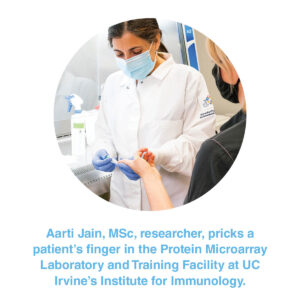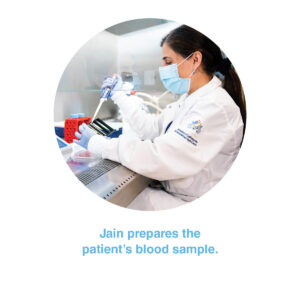UC Irvine professor Phil Felgner and his research team hit the ground running studying all things COVID-19.
Since early spring, an invisible enemy invaded the U.S. That enemy went unseen to the masses and gave other forms of invasion a run for its money. To the tune of an estimated $8 trillion dollars to the U.S. economy, this enemy we know as COVID-19 has caused global shutdowns, new social protocols and so much more.
Phil Felgner, Ph.D., professor of Physiology and Biophysics at UCI’s School of Medicine, director of UCI’s Vaccine Research and Development Center, has been studying COVID-19 well before facemasks, economic shutdowns and social distancing with his team at UC Irvine’s (UCI) Institute for Immunology.
Felgner has been working toward solutions for COVID-19 since January this year and continues to do so in his Protein Microarray Laboratory and Training Facility using UCI intellectual property. In this lab, Felgner has partnered with all corners of his network – from fellow academics to UCI startups and international educational institutions – to bring the best disease detecting ammo he has to the local and worldwide battlefield. 
TRAINING CAMP
Growing up in a small German farm town in Michigan, Felgner discovered the innovations of Henry Ford and Thomas Edison readily available within his community and nearby cities. Early on, the automotive industries then modern technology took hold and fascinated Felgner.
“In the 1950s, Michigan and Detroit were the center of the economic universe at that time, every road came out of Detroit,” said Felgner. “There was a lot of technology, too, all wrapped up in the auto industry. You don’t think of it as technology; it’s just a car. But at that time, it was modern technology.”
As Felgner reached adulthood, he had decided on a career in life sciences thanks to Michigan’s plethora of planetariums, museums and innovators placing a large scientific influence on the thriving Midwest state. He received his Ph.D. in Neurosciences and Biochemistry at Michigan State University and from there, moved to Charlottesville, Virginia, for his postdoc work in biophysics.
In 1982, Felgner made his way to Palo Alto, California, where he began his career at Syntex, a pharmaceutical company or as he describes as an early example of a biotechnology company. At Syntex, Felgner developed a gene therapy technology and in 1988, started his own company, Vical, and discovered he could produce vaccines based on this therapy.
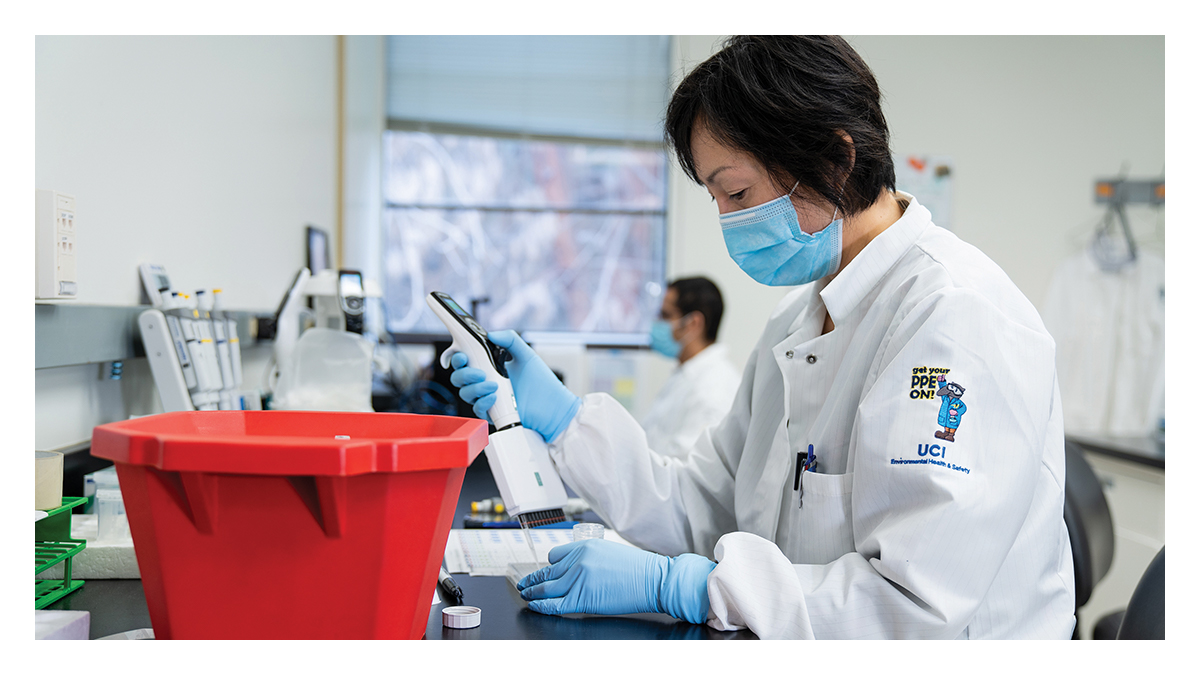
“Instead of administering genes to treat a genetic disorder, we could administer genes that encoded proteins from viruses and bacteria,” said Felgner. “So when you administer those genes and you get a gene product, the immune system thinks it’s infected and responds to how the protein is being made.”
According to Felgner, this discovery is the basis for some of the COVID-19 vaccines in clinical trials today.
MOVES AND COUNTERMOVES
After 10 years of trying to understand the subtleties of the technology, Felgner came to UCI where he could have the opportunity to study it more in depth and take advantage of the newly developed genome sequencing of microorganisms.
“The first microorganism genomes being sequenced were in the late 1990s, so there was basically nothing available,” said Felgner. “We thought if we could get the sequence data, we could make all the proteins and better vaccines.”
In a post-9/11 world where biodefense issues and biological weapons became top-of-mind for much of the country, Felgner’s lab received funding from the National Institutes of Health to develop a way to create all the proteins from any infectious agent. From there, Felgner and his team developed a protein microarray chip that could be used to measure antibodies from anybody who might have been exposed to any infectious disease. At the time, Felgner was researching diseases like tularemia, Query fever and Ebola virus.
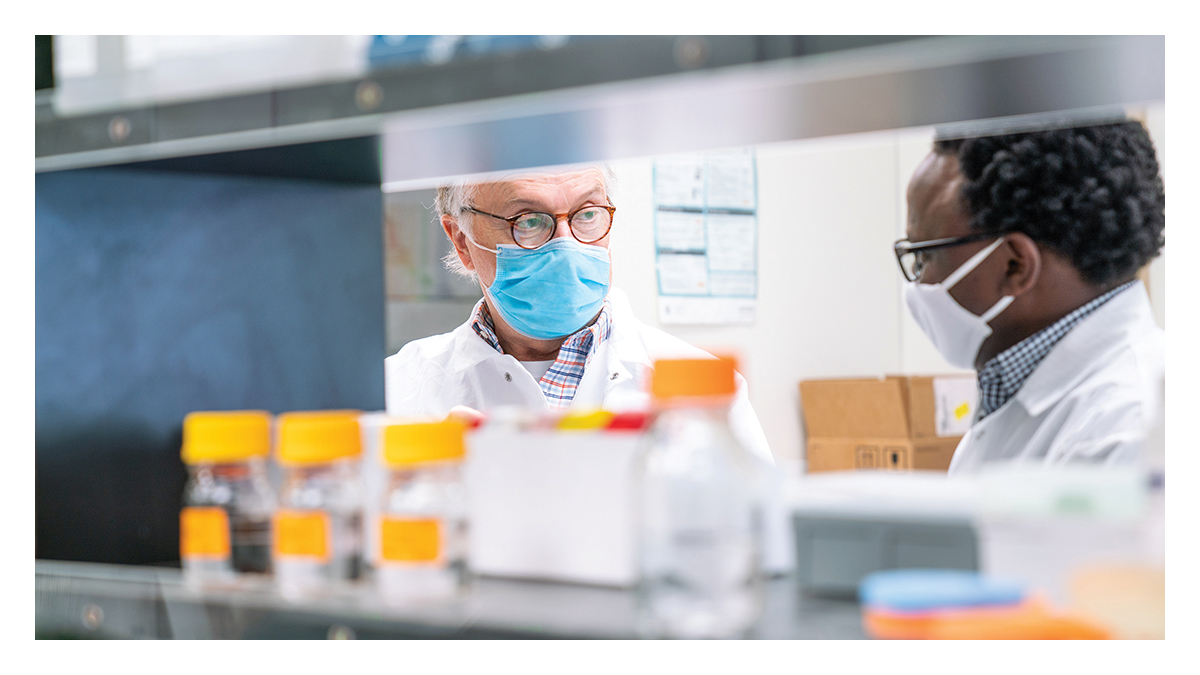
“Tularemia is very infectious. It just takes one or two organisms in your lung to make you experience an infection,” said Felgner. “It was calculated that if you made a powder out of that and put it into an airplane, you could drop it over Manhattan and large numbers of people can become ill from the infection.”
During this tumultuous time in history, Felgner established UCI’s Vaccine R&D Center, where the team studies these infectious diseases and develops potential vaccines.
Infectious organisms contain a multitude of different proteins, and if the wrong protein is chosen, a good vaccine will not likely be developed. Felgner’s microarray technology narrows down the specific proteins and compares them to other similar disease proteins to help configure antibodies and a potential vaccine.
20 YEARS AT UCI
This year marks Felgner’s 20th anniversary at UCI and what a momentous year it has been for his lab. Before the pandemic, Felgner and his team were studying respiratory infections in a group of 1,500 students residing in a dormitory at the College of Art in Maryland. From this study and a partnership with Sino Biologicals, a global reagents company based in China, Felgner was able to easily transition his team’s focus to SARS-CoV-2, the virus that causes COVID-19.

“For the dormitory study we had six respiratory viruses,” said Felgner. “And one of the most important is, guess what, coronavirus. It causes the ‘common cold’ that we get almost every year, everybody has antibodies against it.”
In February, while COVID-19 invaded the globe, Felgner attended a conference in Argentina, narrowly missing the first case of COVID-19 in Brazil.
“One of the amazing things about that trip to Argentina is there were almost no cases in South America,” said Felgner. “And the day we were leaving Argentina was the first day of the Carnival in Brazil … also when the first coronavirus case was diagnosed in Brazil. We were flying out on that very auspicious time.”
In March, COVID-19 detection and antibody tests became the new frontier in vaccines. Felgner and his team pivoted their focus to develop a COVID-19 Coronavirus Antigen Microarray that detects antibodies against coronavirus-infected people. The microarray technology, one of Felgner’s UCI intellectual properties, uses a drop of blood from a finger stick to detect if a person has been exposed to COVID-19.
The microarray test, the size of a computer chip, holds hundreds of different types of disease proteins, such as dengue fever, malaria and now, 34 coronavirus antigens, or 33 antigens from six other harmful viruses that cause respiratory infections. The blood sample is tested against each of these to detect antibodies to determine a person’s exposure to then define a person’s antibody response.
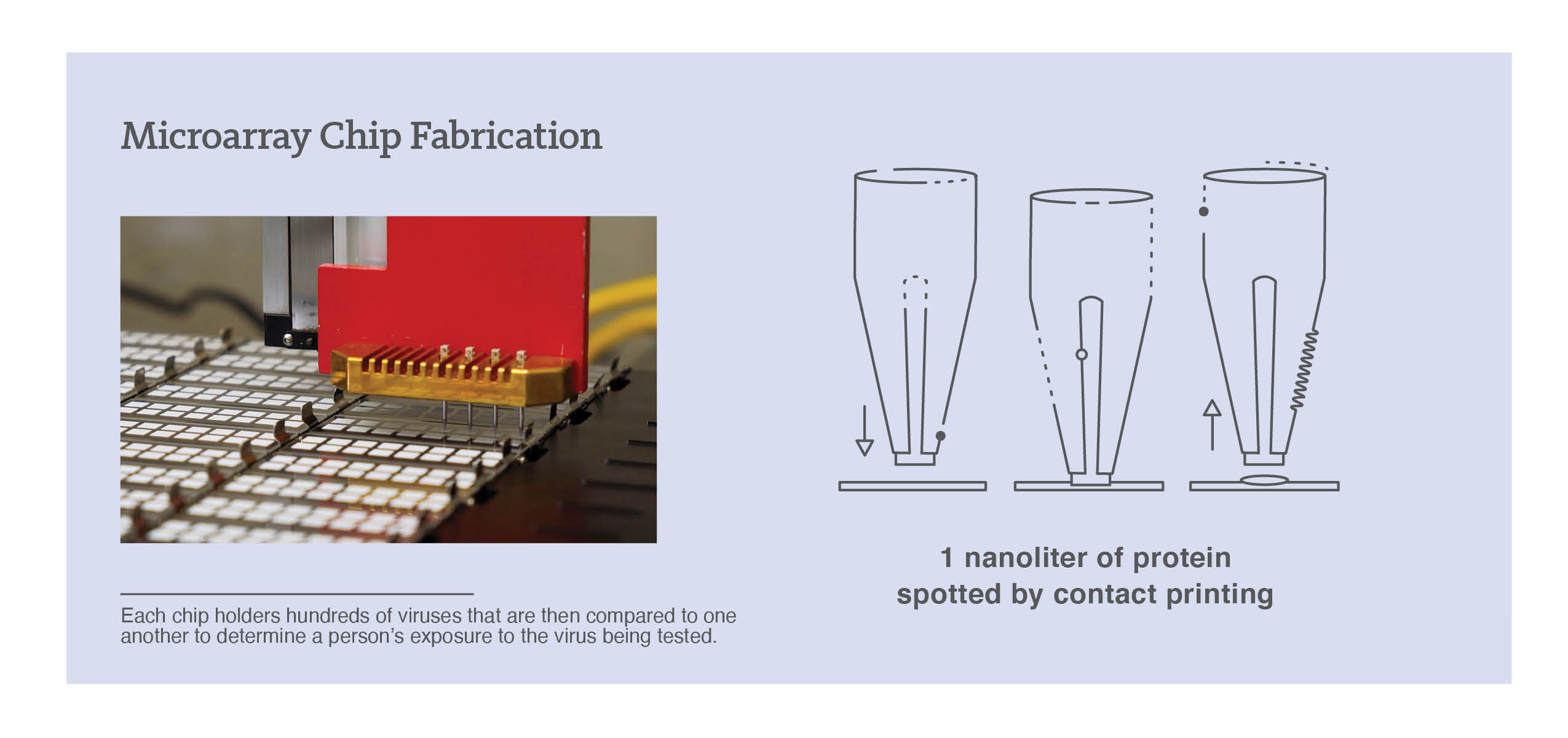
The technology was used in a six-month study on UCI healthcare workers beginning in May, to better understand the risk of virus exposure in different areas of the hospital. This study surveyed blood specimens of 4,000 residents collected at 10 drive-through locations across Orange County.
WORKING TOGETHER TO FIGHT ONE BATTLE
In summer 2020, Felgner’s startup company, Nanommune, combined forces with another UCI startup company and former Wayfinder team, Velox Biosystems, to develop a rapid high-throughput COVID-19 serological test. The test detects antibodies within two to three days with more accuracy and provides more information about how the viruses are interacting within a person’s immune system. Both companies, powered by UCI intellectual property, are aiming to develop a high-quality test.

“It is truly inspiring that Dr. Felgner is always working and trying to help the community and advance the science,” said Byron Shen, Ph.D., MBA, Velox Biosystems CEO. “And the two companies – Nanommune and Velox – have been working extraordinarily well together to develop rapid COVID-19 countermeasures.”
As more information about the virus develops, Felgner pursues more partnerships with fellow academics and companies to learn more about COVID-19 and find ways to defeat this invisible enemy.
“We’ve been doing tremendous things and to then see that it actually is producing useful information is really rewarding to me,” said Felgner. “All the collaborations are just really great to see. When the medical professionals look at the data, it has rewarding level of meaning and importance for them, and for us.”
Learn more about UCI’s Vaccine R&D Center.
Photos, Video & Illustrations: Julie Kennedy, UCI Beall Applied Innovation
Below are photos of Arti Jain, MSc, researcher, conducting a blood draw at UC Irvine’s Institute for Immunology:
